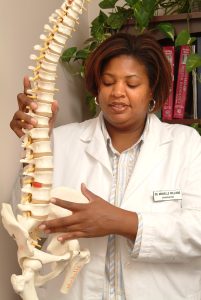9.3 Healthcare Practitioners
There are a number of regulated healthcare practitioners who are involved in the day-to-day care of patients both in and outside the hospital. The most common healthcare practitioners found in the hospital and community are discussed below. In health care, there are a number of professionals who work collaboratively to provide the best possible care for patients. Working as a team ensures that patients receive the required holistic care needed for optimal health outcomes.

Chiropractors are trained in the prevention, assessment, and treatment of the musculoskeletal system, including the spine and the nervous system. They focus on patient education and treatment, providing spinal adjustments, nutrition information, and injury prevention. They do so without the use of pharmaceuticals or surgical procedures (Carter & Rutherford, 2020). Fig. 9.7 shows a chiropractor educating a patient about their spine and the required treatment for their condition.
Dietitians assess, plan, implement, and evaluate interventions related to the nutritional needs of patients. They work with patients with regular dietary needs, as well as those on therapeutic diets. They also provide dietary education to patients, families, and other healthcare providers. In addition, dietitians work with other members of the healthcare team when a client has dietary needs related to physical disorders such as dysphagia.
Health care aides (HCAs) generally work in hospitals and long-term care facilities and assist patients with daily tasks such as bathing, dressing, feeding, and toileting.
Kinesiologists work in a variety of healthcare settings and help patients with pain management, injury prevention, and health promotion through a focus on biomechanics (Carter & Rutherford, 2020).
Midwives work in hospitals, birthing centres, community clinics, and patients’ homes. They provide gynecological exams, family planning advice, prenatal care, and management of low-risk labour and delivery. Most midwives are nurses with advanced training.
There are different types of nurses in medical settings:
- Licensed practical nurses (LPNs) typically work in hospitals and provide patient care such as collecting patient assessment information, administering medications, and performing nursing procedures according to their scope of practice. LPNs generally complete a two- to three-year diploma and must write a licensing exam.
- Registered nurses (RNs) provide similar patient care as LPNs but with an increased scope of practice. They also use the nursing process as a critical-thinking model as they make decisions and use clinical judgement regarding patient care. RNs must complete a four-year degree and pass a licensing exam in order to practice. A group of RNs can be seen in Fig. 9.8.

Key Concept
Nurse practitioners (NPs) are RNs who complete two years of additional graduate work and licensing. They work in a variety of settings and complete physical examinations, diagnose and treat common acute illnesses, and manage chronic illnesses. NPs can work independently, order laboratory and diagnostic tests, and prescribe medications.
Occupational therapists (OTs) work in a variety of settings in the hospital and the community. They assess, plan, implement, and evaluate many different types of interventions, including those that help patients achieve their highest possible level of independence in activities of daily living such as bathing, grooming, eating, and dressing. They also provide adaptive devices such as long shoehorns so patients can put their shoes on, sock pulls for pulling on socks, or adaptive cutlery to facilitate independent eating. OTs can also assess the home for safety and evaluate the patient’s need for assistive devices for when they are discharged from the hospital or rehabilitation facility.
Pharmacists work in hospitals, medical centres, and the general community. They ensure medication safety and are a vital resource for other medical professionals who have questions or concerns about the medications being administered to patients. Pharmacists not only ensure that patients get the correct medication and dosing, but also that they have the guidance they need to use the medication safely and effectively. Fig. 9.9 shows a group of pharmacists working in a community setting.

Physician assistants (PAs) require a bachelor’s degree plus two or three years of additional physician assistant training (Albany Medical College, 2022). They are licensed to practise medicine under the supervision of a physician in a clinic or hospital. PAs can diagnose and treat patients and prescribe medicine, and some may be surgical assistants (Albany Medical College, 2022).
Physiotherapists (PTs) practise in all healthcare environments, including the home, hospital, and general community. They are licensed healthcare professionals who assess, plan, implement, and evaluate interventions, including those related to the patient’s strength, mobility, balance, gait, coordination, and joint range of motion. Treatments may include exercises, massage, joint manipulation, and occupational retraining (Carter & Rutherford, 2020).
Podiatrists provide care and services to patients who have issues with their feet. Patients with diabetes often have foot problems, so podiatrists work with them to clip toenails and provide foot care to prevent injuries and other complications.
Psychologists provide mental health services to patients with mental health concerns or disorders. They cannot prescribe medications but can assist with various forms of counselling and provide psychological support to patients in the hospital and community.
Respiratory therapists (RTs) work in hospitals to treat patients with respiratory-related conditions. Their specialized respiratory care includes managing oxygen therapy, drawing arterial blood gases, managing patients on specialized oxygenation devices such as mechanical ventilators, CPAP, and Bi-PAP machines, and administering respiratory medications such as inhalers and nebulizers. They also serve as an integral part of code teams during cardiac and respiratory arrests. Fig. 9.10 shows an RT providing complex care to a patient in critical condition.

Social workers work in hospitals and the community to provide psychological support to patients and connect them with community resources. They ensure continuity of care and make sure the patient has the resources they require when they leave the hospital.
Speech therapists assess, diagnose, and treat communication and swallowing disorders. They may help patients with aphasia or swallowing disorders such as dysphagia. They treat patients in collaboration with other members of the healthcare team.
Exercise
Attribution
Unless otherwise indicated, material on this page has been adapted from the following resource:
Ernstmeyer, K., & Christman, E. (Eds.). (2021). Nursing fundamentals. Chippewa Valley Technical College. https://wtcs.pressbooks.pub/nursingfundamentals is licensed under CC BY 4.0
References
Albany Medical College. (2022). Medical staff titles & terminology. https://www.amc.edu/PhysicianDirectory/pages/medical_staff_terminology.cfm#:~:text=An%20%E2%80%9Cintern%E2%80%9D%20is%20a%20physician,after%20graduating%20from%20Medical%20School.&text=A%20medical%20student%20is%20a,to%20earn%20a%20medical%20degree
Carter, K., & Rutherford, M. (2020). Building a medical terminology foundation. eCampusOntario. https://ecampusontario.pressbooks.pub/medicalterminology/ licensed under CC BY 4.0
Image Credits (images are listed in order of appearance)
Chiropractor – DPLA – 92d3e67cd3496fa68b28390a5a2d8de4 by National Archives at College Park, Public domain
Innovarx Global Health Nurses by Haddy Sowe, CC BY-SA 4.0
Multicare pharmacist by Woonjiawei, CC BY-SA 4.0
Respiratory therapist by Rcp.basheer, CC BY-SA 3.0
No speech
Difficulty eating

